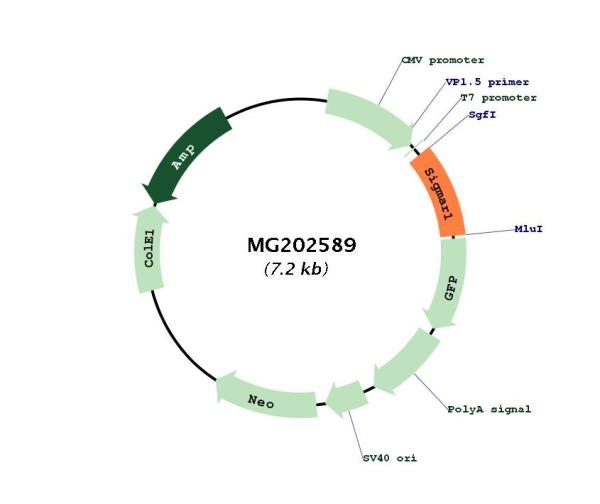Sigmar1 (NM_011014) Mouse Tagged ORF Clone
CAT#: MG202589
- TrueORF®
Sigmar1 (tGFP-tagged) - Mouse opioid receptor, sigma 1 (Oprs1)
ORF Plasmid: DDK
Lentiviral Particles: DDK DDK w/ Puro mGFP mGFP w/ Puro
AAV Particle: DDK
"NM_011014" in other vectors (6)
Specifications
| Product Data | |
| Type | Mouse Tagged ORF Clone |
| Tag | TurboGFP |
| Symbol | Sigmar1 |
| Synonyms | mSig; O; Oprs1; Si; Sig1R; sigma1R |
| Vector | pCMV6-AC-GFP |
| E. coli Selection | Ampicillin (100 ug/mL) |
| Mammalian Cell Selection | Neomycin |
| Sequence Data |
>MG202589 representing NM_011014
Red=Cloning site Blue=ORF Green=Tags(s) TTTTGTAATACGACTCACTATAGGGCGGCCGGGAATTCGTCGACTGGATCCGGTACCGAGGAGATCTGCC GCCGCGATCGCC ATGCCGTGGGCCGCGGGACGGCGGTGGGCATGGATCACCCTGATTCTGACTATTATCGCAGTGCTGATCC AGGCCGCCTGGTTGTGGCTGGGCACTCAAAACTTCGTCTTCTCTAGAGAAGAAATAGCGCAGCTTGCTCG ACAGTATGCGGGGCTGGACCATGAGCTTGCCTTCTCTCGGCTGATCGTGGAGCTGCGGAGGCTGCACCCA GGCCACGTGCTGCCGGATGAGGAGCTGCAGTGGGTATTTGTGAACGCGGGCGGCTGGATGGGCGCCATGT GTATTCTGCACGCCTCGCTGTCTGAGTACGTGCTGCTCTTCGGCACCGCCCTGGGCTCCCATGGCCATTC GGGACGATACTGGGCTGAGATTTCTGACACCATCATCTCTGGCACCTTCCACCAATGGAAAGAGGGCACC ACGAAAAGTGAGGTCTTCTACCCAGGAGAGACAGTTGTACACGGGCCTGGAGAAGCAACGGCTCTGGAGT GGGGACCAAACACGTGGATGGTGGAGTACGGCCGGGGTGTTATTCCGTCTACCCTGTTCTTTGCACTAGC CGACACTTTCTTCAGCACCCAGGACTACCTCACACTCTTCTATACCCTTCGGGCCTATGCCCGGGGCCTC CGGCTTGAGCTTACCACCTACCTCTTTGGCCAAGACTCC ACGCGTACGCGGCCGCTCGAG - GFP Tag - GTTTAA >MG202589 representing NM_011014
Red=Cloning site Green=Tags(s) MPWAAGRRWAWITLILTIIAVLIQAAWLWLGTQNFVFSREEIAQLARQYAGLDHELAFSRLIVELRRLHP GHVLPDEELQWVFVNAGGWMGAMCILHASLSEYVLLFGTALGSHGHSGRYWAEISDTIISGTFHQWKEGT TKSEVFYPGETVVHGPGEATALEWGPNTWMVEYGRGVIPSTLFFALADTFFSTQDYLTLFYTLRAYARGL RLELTTYLFGQDS TRTRPLE - GFP Tag - V |
| Chromatograms |
CHROMATOGRAMS
 Sequencher program is needed, download here. |
| Restriction Sites |
SgfI-MluI
Cloning Scheme for this gene
Plasmid Map

|
| ACCN | NM_011014 |
| ORF Size | 669 bp |
| OTI Disclaimer | The molecular sequence of this clone aligns with the gene accession number as a point of reference only. However, individual transcript sequences of the same gene can differ through naturally occurring variations (e.g. polymorphisms), each with its own valid existence. This clone is substantially in agreement with the reference, but a complete review of all prevailing variants is recommended prior to use. More info |
| OTI Annotation | This clone was engineered to express the complete ORF with an expression tag. Expression varies depending on the nature of the gene. |
| Product Components | The ORF clone is ion-exchange column purified and shipped in a 2D barcoded Matrix tube containing 10ug of transfection-ready, dried plasmid DNA (reconstitute with 100 ul of water). |
| Reconstitution | 1. Centrifuge at 5,000xg for 5min. 2. Carefully open the tube and add 100ul of sterile water to dissolve the DNA. 3. Close the tube and incubate for 10 minutes at room temperature. 4. Briefly vortex the tube and then do a quick spin (less than 5000xg) to concentrate the liquid at the bottom. 5. Store the suspended plasmid at -20°C. The DNA is stable for at least one year from date of shipping when stored at -20°C. |
| Reference Data | |
| RefSeq | NM_011014.3 |
| RefSeq Size | 1591 bp |
| RefSeq ORF | 672 bp |
| Locus ID | 18391 |
| UniProt ID | O55242 |
| Cytogenetics | 4 A5 |
| Gene Summary | This gene encodes a transmembrane protein located in the endoplasmic reticulum. The encoded protein is a receptor that binds several endogenous ligands, including N,N-dimethyltryptamine, progesterone and pregnenolone and a variety of of non-opiate compounds. The encoded protein plays a role in regulating the activity of ion channels, acting as a chaperone and protecting cells from oxidative stress. In humans, this receptor has been associated with Alzheimer's and Parkinson's diseases, stroke and numerous disease conditions such as depression, pain and addiction. Alternative splicing results in multiple transcript variants encoding different isoforms.[provided by RefSeq, Nov 2013] |
Documents
| Product Manuals |
| FAQs |
| SDS |
Resources
Other Versions
| SKU | Description | Size | Price |
|---|---|---|---|
| MC200340 | Sigmar1 (untagged) - Mouse sigma non-opioid intracellular receptor 1 (Sigmar1), (10ug) |
USD 300.00 |
|
| MR202589 | Sigmar1 (Myc-DDK-tagged) - Mouse sigma non-opioid intracellular receptor 1 (Sigmar1) |
USD 300.00 |
|
| MR202589L1 | Lenti ORF clone of Sigmar1 (Myc-DDK-tagged) - Mouse sigma non-opioid intracellular receptor 1 (Sigmar1) |
USD 600.00 |
|
| MR202589L2 | Lenti ORF clone of Sigmar1 (mGFP-tagged) - Mouse sigma non-opioid intracellular receptor 1 (Sigmar1) |
USD 600.00 |
|
| MR202589L3 | Lenti ORF clone of Sigmar1 (Myc-DDK-tagged) - Mouse sigma non-opioid intracellular receptor 1 (Sigmar1) |
USD 600.00 |
|
| MR202589L4 | Lenti ORF clone of Sigmar1 (mGFP-tagged) - Mouse sigma non-opioid intracellular receptor 1 (Sigmar1) |
USD 600.00 |
{0} Product Review(s)
Be the first one to submit a review






























































































































































































































































 Germany
Germany
 Japan
Japan
 United Kingdom
United Kingdom
 China
China

